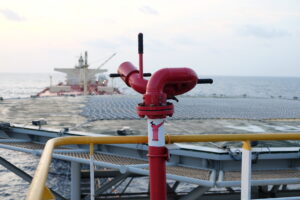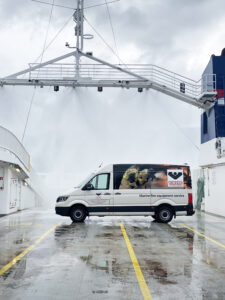21 August 2024 – At a time of heightened alertness to ship fires, key chemicals in the foams used to put them out are running dry, risking safety on board up to 40,000 seagoing vessels.

From 1 January 2026, the regulation of firefighting foams on ships will start to catch up with the global rejection of perfluoro-octane sulfonic acid (PFOS). From that date, use of PFOS will be prohibited onboard new ships, with existing vessels needing to replace them by their first survey thereafter.
Recognized as Persistent Organic Pollutants (POPs), PFOS were discontinued by major US chemical producers over a decade ago under Environmental Protection Agency pressure, with their use also tightly restricted in the EU.
Where firefighting foams are concerned, however, lack of maritime restriction has seen use of these durable compounds persist, even though the International Agency for Research on Cancer classifies them as “carcinogenic to humans”.
Once new regulations on PFOS in firefighting foams enter into force, Port State Control is likely to ensure that they have the “teeth” that some other areas of maritime legislation lack. Even so, at first sight the maritime schedule to phase out PFOS appears manageable. Requiring removal, disposal and replacement by existing vessels by their first survey within five years on 1 January 2026, the job is one for scheduled drydocking.
But the prospect of a pedestrian, if orderly maritime phase-out for these ‘forever chemicals’ in firefighting foams is fast evaporating.

First, while marine insurers continue to provide cover for firefighting systems holding PFOS, latest guidance indicates that this no longer extends to claims covering marine pollution.
Second, regional regulators have accelerated their restriction of another hazardous compound – polyfluoroalkyl substances (PFAS) – which are also widely used in foam firefighting systems on board vessels and offshore platforms.
Firefighting foam sea change
In June 2023, the European Chemicals Agency recommended an EU ban on PFAS in firefighting foams. EPA also issued new reporting rules covering the manufacture and importation of PFAS in the U.S. in October last year, as one of several measures aiming to accelerate their phase-out. Threats of outright bans on PFAS are also under consideration in several European countries, Canada and Australia.
As a consequence, ship owners and managers are now learning that the supply of firefighting foams which include PFAS – let alone PFOS – is drying up.
VIKING Life-Saving Equipment is the industry’s leading supplier of life saving appliances, and also offers full foam inspection, replacement and certification services. The company reports that five leading marine foam OEMs have discontinued products that include PFAS during 2024.
“Shipping is only a minor consumer of these products, and what is becoming clear is that rather than legislation, the driver for transition to different types of firefighting foams has quickly become OEMs stopping production,” says William Gielen, Global Director of Marine Fire Service. Some suggest that as many as 40,000 ships continue to carry firefighting foams that contain PFAS. They include oil tankers, chemical tankers, rigs and offshore vessels, and engine room systems on a wider pool of vessels.
“It’s vital that owners and operators get ahead of developments and factor in the switch to fluorine-free foams now,” Gielen emphasizes. “I don’t think people realize that if foam onboard is condemned from now on or if they need a top up, to comply with existing regulations it’s already an issue.”
First responder
VIKING has undertaken numerous foam replacement projects to date, in Asia, Europe and the Middle East, securing extensive knowledge of the testing, logistics, installation, disposal and certification processes involved.
Replacement foams are readily available, while VIKING has its own laboratory to sample and test the products which are succeeding those containing PFOS and PFAS. However, the life-saving specialist’s awareness campaign also highlights that replacing foams entails work that must be planned and scheduled for drydocking to avoid disruption to operating or charter obligations. Cargo vessels can’t sail without adequate firefighting systems, Gielen points out.
Owners need to be aware that deep cleaning of shipboard systems is required to eradicate all traces of outgoing compounds, he says. Systems will need recalibration for higher viscosity foams, and even re-engineering to include different pump types. Class approvals might also be necessary.
“Because this is a new requirement, class sign-off on new systems specifications can take longer than expected,” he adds.
In a new firefighting foam landscape, there is a benefit in having VIKING involved all through the process, adds Gielen. The company has made arrangements with certified disposal companies to take care of the foams that need replacing, for example, through their incineration and certification management.
“Disposal of old foams is a more significant issue than many will be expecting,” he says, “Some ports don’t have the facilities, for example while auditing the process is part of the regulatory obligation. While we are not a disposal company ourselves, we see this as a critical part of managing the full chain of responsibility for a new mandatory requirement.”
